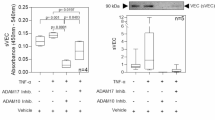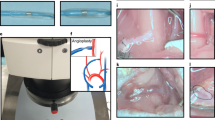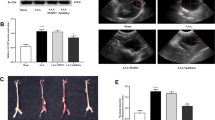Abstract
Pathogenesis of the abdominal aortic aneurysm has been attributed to neovascularization of the aortic wall. However, it is not clear whether angiogenesis persists in the aneurysm. In sections of aneurysms, we determined the immunohistochemical distributions of the αvβ3 integrin, tenascin and endothelial nitric oxide synthase (eNOS), which are markers respectively, of angiogenesis, matrix remodeling and vasoregulatory function. In addition, we used reverse transcription followed by in situ PCR, to determine the distribution of αv mRNA. All aneurysm specimens exhibited extensive increases of wall vascularization as compared with the control aortic wall, and showed the presence of perivascular inflammatory exudates containing macrophages and lymphocytes. The neovascularization consisted of thick-walled vessels in the media and adventitia, and capillaries in the subintima. The majority of vessels stained positively for the αvβ3 antigen and eNOS. Tenascin was deposited as bands that circumscribed thick-walled vessels. The distribution of av mRNA was extensive and was positive even in those vessels that failed to stain for the αvβ3 protein. No staining was evident in control aortas for the αvβ3 antigen, tenascin or αv mRNA. The upregulation of av mRNA and the αvβ3 integrin in blood vessels surrounded by a matrix expressing tenascin, indicates that angiogenesis is an ongoing process in the mature aortic aneurysm.
Similar content being viewed by others
Article PDF
Author information
Authors and Affiliations
Rights and permissions
This is an Open Access article distributed under the terms of the Creative Commons Attribution Non-Commercial License (http://creativecommons.org/licenses/by-nc/3.0/) which permits unrestricted non-commercial use, distribution, and reproduction in any medium, provided the original work is properly cited.
About this article
Cite this article
Paik, D., Fu, C., Bhattacharya, J. et al. Ongoing angiogenesis in blood vessels of the abdominal aortic aneurysm. Exp Mol Med 36, 524–533 (2004). https://doi.org/10.1038/emm.2004.67
Published:
Issue date:
DOI: https://doi.org/10.1038/emm.2004.67
Keywords
This article is cited by
-
Evaluation of the thrombus of abdominal aortic aneurysms using contrast enhanced ultrasound - preliminary results
Scientific Reports (2016)
-
Vascular endothelial growth factor gene polymorphisms and intracranial aneurysms
Acta Neurochirurgica (2013)
-
Evidence for angiogenesis in Parkinson’s disease, incidental Lewy body disease, and progressive supranuclear palsy
Journal of Neural Transmission (2012)
-
RGD-Conjugated Human Ferritin Nanoparticles for Imaging Vascular Inflammation and Angiogenesis in Experimental Carotid and Aortic Disease
Molecular Imaging and Biology (2012)
-
Expression of vascular endothelial growth factor receptor-1/-2 and nitric oxide in unruptured intracranial aneurysms
Neurological Sciences (2010)



